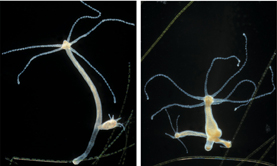28.2 Movement and Support
 What are the three types of skeletons?
What are the three types of skeletons? How do muscles enable movement?
How do muscles enable movement?
hydrostatic skeleton • exoskeleton • molting • endoskeleton • joint • ligament • tendon
Compare/Contrast Table As you read, create a table comparing and contrasting the three types of skeletons.
THINK ABOUT IT As a dragonfly hovers over a stream, a trout leaps out of the water to catch it. An earthworm wriggles through leaf litter nearby. A falcon streaks overhead, hunting a mouse scampering across a field. All these invertebrates and vertebrates face similar challenges as they move through air or water, or over land. In order to move, animals use different structures that work in similar ways.
Types of Skeletons
 What are the three types of skeletons?
What are the three types of skeletons?
To move efficiently, all animals must do two things. First, they must generate physical force. Then, they must somehow apply that force against air, water, or land in order to push or pull themselves around.
Skeletal Support An animal's ability to move efficiently is greatly enhanced by rigid body parts. Legs push against the ground. Bird wings push against air, and fins or flippers apply force against water. Each of these body parts is supported by some sort of skeleton.  Animals have three main kinds of skeletal systems: hydrostatic skeletons, exoskeletons, and endoskeletons.
Animals have three main kinds of skeletal systems: hydrostatic skeletons, exoskeletons, and endoskeletons.
▸ Hydrostatic Skeletons Some invertebrates, such as cnidarians and annelids, have hydrostatic skeletons. The hydrostatic skeleton of a cnidarian such as a hydra, for example, consists of fluids held in a gastrovascular cavity that can alter the animal's body shape drastically by working with contractile cells in its body wall. When a hydra closes its mouth and the cells encircling its body wall constrict, the animal elongates and its tentacles extend, as shown in the left photo of Figure 28–8. Because water is not compressible, constricting the cavity elongates the animal, somewhat like a water balloon that has been squeezed. A hydra often sits in this position for hours, waiting for prey to swim by. If it is disturbed, its mouth opens, allowing water to flow out, and longitudinal cells in its body wall contract, shortening the body, as in the right photo of Figure 28–8.

FIGURE 28–8 Hydrostatic Skeleton Some invertebrates, such as this hydra, have hydrostatic skeletons. When a hydra closes its mouth, water trapped in its body causes it to elongate (left). When it opens its mouth again, water is released, and it becomes shorter (right).

Table of Contents
- Formulas and Equations
- Applying Formulas and Equations
- Mean, Median, and Mode
- Estimation
- Using Measurements in Calculations
- Effects of Measurement Errors
- Accuracy
- Precision
- Comparing Accuracy and Precision
- Significant Figures
- Calculating With Significant Figures
- Scientific Notation
- Calculating With Scientific Notation
- Dimensional Analysis
- Applying Dimensional Analysis




